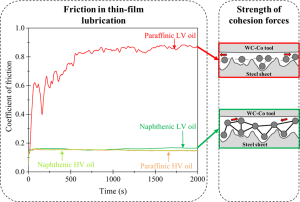Researchers from Laboratory for tribology and interface nanotechnology published the study of base lubricants for green stamping in Friction (IF: 6.8). The researchers show how the chemical structure and viscosity of base lubricants effect on tribological performance of stamping contact.

The requirements for green and sustainable manufacturing mean that stamping lubricants must be continuously re-evaluated and re-designed. In the study we investigated the tribological performance different lubricants for stamping, namely four base oils with different chemical structures (paraffinic and naphthenic) and viscosities (2 and 20 cSt. Low-viscosity (LV) naphthenic oil performs very like both high-viscosity (HV) oils. A surprising exception is the LV paraffinic oil, with several-times-higher friction and wear compared to dry contact. This is due to the excellent wetting-spreading and very low cohesion forces that enable oil to escape from extremely thin-film contacts because the viscosity is so low, leading to lubricant starvation. In contrast, HV oils provide a sufficiently thick lubricating film, while strong cohesive forces help in the film’s strength, lessening wear and reducing friction. In thin-film lubrication with LV oils, such as when stamping, it is thus extremely important that the lubricant’s wetting behaviour and viscosity are sufficient to provide enough film in the contact and prevent starvation, thus ensuring lower friction, less wear and a longer lifetime of the contact.
Article is avaliable on the website: https://doi.org/10.1007/s40544-022-0706-6
